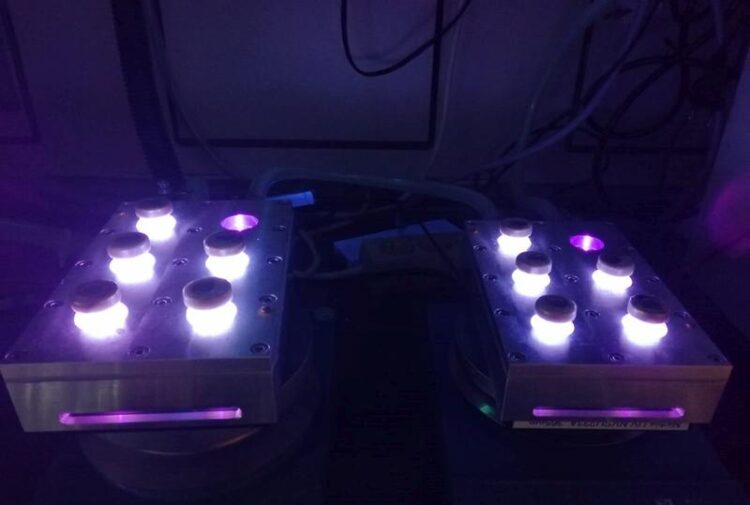DNA damage caused by migrating light energy

DNA is exposed to UV radiation from LEDs to study how far the photoenergy migrates.
(Photo: Arthur Kuhlmann, KIT)
UV radiation modifies DNA also far away from the entry point of light – publication in Angewandte Chemie.
Ultraviolet light endangers the integrity of human genetic information and may cause skin cancer. For the first time, researchers of Karlsruhe Institute of Technology (KIT) have demonstrated that DNA damage may also occur far away from the point of incidence of the radiation. They produced an artificially modeled DNA sequence in new architecture and succeeded in detecting DNA damage at a distance of 30 DNA building blocks. The results are reported in Angewandte Chemie (DOI: 10.1002/anie.202009216).
“So far, we have thought that it is impossible for light energy to be transmitted so far in the DNA and cause damage there,” says Professor Dr. Hans-Achim Wagenknecht from KIT’s Institute of Organic Chemistry. The research results are presented in Angewandte Chemie and are ranked as extraordinarily important and in the best ten percent by the journal. For the study, a synthetically produced, modified DNA of a certain architecture was used. At certain points of this short gene section, researchers inserted a xanthone molecule as photoenergy injector. To specify where the UV radiation produced by LEDs was to cause damage in the experiment, scientists inserted pairs of thymines at defined distances from this light injector. Thymine is one of four nucleobases and, hence, one of the major building blocks of DNA. The most frequent damage of DNA caused by light results from linking neighboring thymines: Due to the light energy, they form solid compounds of cyclobutane pyrimidine dimers (CPD).
Having defined the positions of CPD formation, the team succeeded in proving migration of photoenergy over 30 DNA building blocks corresponding to a distance of up to 10.5 nanometers. “This surprisingly long range is crucial to the understanding of DNA photodamage,” Wagenknecht says. CPD damage is considered the molecular cause of skin cancer, because genetic information can no longer be read or cannot be read correctly.
The question of how far energy can migrate is still open. Above all, the scientists wanted to find out where photodamage develops. Another important aspect is that xanthones artificially introduced into the DNA as light injectors may be contained in many common substances, such as antibiotics, and may increase light sensitivity of the skin after intake.
###
Doctoral researcher Arthur Kuhlmann and student Larissa Bihr from the team of Wagenknecht were largely involved in the publication. The project was funded by the German Research Foundation (DFG) with a total of about EUR 430,000 for the position of the doctoral researcher and consumables. In the next step, the group will study the mechanism of energy migration in detail.
Original Publication:
Arthur Kuhlmann, Larissa Bihr, Hans-Achim Wagenknecht: How far does energy migrate in DNA and cause damage? Evidence for long-range photodamage to DNA. Angewandte Chemie, 2020, DOI: 10.1002/anie.202009216
Further material:
Click here for the publication in Angewandte Chemie: https:/
Contact for this press release:
Dr. Joachim Hoffmann, Editor/Press Officer, Phone: +49 721 608-41151, joachim.hoffmann@kit.edu
Being “The Research University in the Helmholtz Association”, KIT creates and imparts knowledge for the society and the environment. It is the objective to make significant contributions to the global challenges in the fields of energy, mobility, and information. For this, about 9,300 employees cooperate in a broad range of disciplines in natural sciences, engineering sciences, economics, and the humanities and social sciences. KIT prepares its 24,400 students for responsible tasks in society, industry, and science by offering research-based study programs. Innovation efforts at KIT build a bridge between important scientific findings and their application for the benefit of society, economic prosperity, and the preservation of our natural basis of life. KIT is one of the German universities of excellence.
Media Contact
All latest news from the category: Life Sciences and Chemistry
Articles and reports from the Life Sciences and chemistry area deal with applied and basic research into modern biology, chemistry and human medicine.
Valuable information can be found on a range of life sciences fields including bacteriology, biochemistry, bionics, bioinformatics, biophysics, biotechnology, genetics, geobotany, human biology, marine biology, microbiology, molecular biology, cellular biology, zoology, bioinorganic chemistry, microchemistry and environmental chemistry.
Newest articles

An Endless Loop: How Some Bacteria Evolve Along With the Seasons
The longest natural metagenome time series ever collected, with microbes, reveals a startling evolutionary pattern on repeat. A Microbial “Groundhog Year” in Lake Mendota Like Bill Murray in the movie…

Witness Groundbreaking Research on Achilles Tendon Recovery
Achilles tendon injuries are common but challenging to monitor during recovery due to the limitations of current imaging techniques. Researchers, led by Associate Professor Zeng Nan from the International Graduate…

Why Prevention Is Better Than Cure—A Novel Approach to Infectious Disease Outbreaks
Researchers have come up with a new way to identify more infectious variants of viruses or bacteria that start spreading in humans – including those causing flu, COVID, whooping cough…



